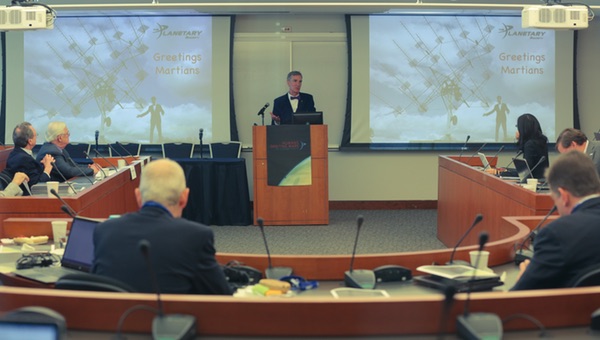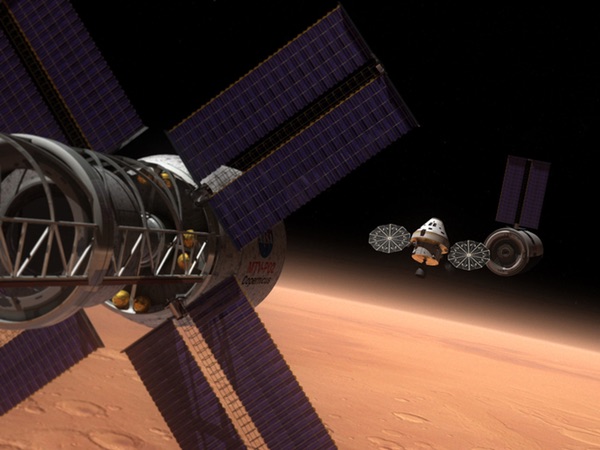Doing humans to Mars on—and within—a budgetby Jeff Foust
|
| “There’s no ‘Kennedy moment’ involved, there’s no extraordinary demand for doubling of the NASA budget,” Nye said of the budget of the proposed plan. |
Earlier this year, for example, NASA associate administrator for human exploration and operations William Gerstenmaier told a NASA Advisory Council committee that the agency wasn’t ready to update a Mars design reference mission last revised in 2009, citing changes in technology and our understanding of water and other resources human crews could use there. “I don’t think I’m quite ready for that yet,” he said when asked about updating that 2009 architecture. “We’re still really learning.”
That has not stopped others from formulating their own concepts. The latest, developed at the Jet Propulsion Laboratory, was discussed last week at an invitation-only workshop hosted by The Planetary Society in Washington. That “Humans Orbiting Mars” workshop brought together people from NASA, industry, and academia to discuss the plan and how it could, possibly, be implemented.
While the workshop was closed to the media, The Planetary Society held a press conference on April 2 to offer some details about this latest Mars architecture. Scott Hubbard, the former NASA “Mars czar” and chair of the workshop, said the effort came out of frustration with both NASA’s vague plans and a separate approach included in the report last year by the National Research Council’s (NRC’s) Committee on Human Spaceflight. That latter report said significant increases in NASA’s budget were required to allow human mission to Mars in the 2030s; else, such missions could be delayed to 2050 or later (see “A new pathway to Mars”, The Space Review, June 9, 2014).
“Neither of those answers were acceptable,” Hubbard said of the NASA and NRC plans.
Since last year, a small group at JPL, using internal funds, had developed an alternative architecture. In addition, The Aerospace Corporation performed a cost analysis of those plans, much as they did for the NRC’s report. The broad conclusion The Planetary Society announced Thursday: it’s possible to get humans to Mars orbit in 2033, and on the surface as soon as 2039, within NASA’s current budget, assuming increases for inflation.
“Not only did we see a reasonable example of a series of missions that would enable humans to get out to Mars, we saw the cost analysis,” said Bill Nye, CEO of The Planetary Society. “There’s no ‘Kennedy moment’ involved, there’s no extraordinary demand for doubling of the NASA budget.”
The organization, though, was reticent to offer details about this approach, saying the JPL team that developed the study planned to present the results at a conference later this year. A report about the workshop, which will also include details about the new mission architecture, will also be released later this year.
 Bill Nye speaks to participants at the “Humans Orbiting Mars” Workshop in Washington last week. (credit: Tushar Dayal for The Planetary Society) |
However, Hubbard did offer some broad outlines of the concept under study. It would leverage some key exploration systems already under study, including the Space Launch System (SLS) heavy-lift rocket and Orion spacecraft. That architecture included the initial uncrewed SLS/Orion test flight, Exploration Mission 1 (EM-1), expected to launch some time in 2018. It also included the first crewed SLS/Orion mission, EM-2, in 2021, and a second crewed mission in 2023.
Those missions would be followed in 2025 and 2027 by what Hubbard called “Mars sims,” or crewed long-duration flights in cislunar space designed to test a habitat module required for Mars missions. Another key technology, solar electric propulsion, would be separately tested in 2020.
| “Given what NASA is allowed, and not allowed, to say about its future plans, I think ARM is the best mission that NASA can come up with in the current context,” Logsdon said. |
The crewed mission to Mars orbit would follow in 2033. That would be a 30-month mission, including about a year in Mars orbit. It could, Hubbard said, include a landing on Phobos or Deimos, the two small Martian moons, but not a landing on the Martian surface. While 2033 is a particularly favorable launch window for going to Mars in terms of technical performance, those familiar with the study say that orbital mission could also fly in other, less favorable launch windows.
A crewed “short-stay” landing on Mars would follow in 2039, after some tests at the Moon. Hubbard said the JPL plan included testing an entry, descent, and landing (EDL) technology demonstrator on the Moon in 2026. In 2035, another test would land a crew on the surface of the Moon, although the study does not envision extended missions there, or the creation of a lunar base.
Hubbard and other involved with the workshop didn’t give specific cost estimates, but said that it fit into an inflation-adjusted Mars budget on the assumption that NASA ends its participation on the ISS in 2024, NASA’s current commitment to ISS operations; or 2028, the estimated technical lifetime of the station. “It fits if you end the contribution in 2028,” he said. “It fits extremely well, with even substantial periods of margin, if you were to end in 2024.”
NASA has been emphasizing the development of the Asteroid Redirect Mission (ARM) as a key initial step to going to Mars. Agency officials said last month that their selection of the “Option B” approach for its robotic element—grabbing a boulder off the surface of a larger near Earth asteroid—was based in part on the technology developed for it that could be used for future missions (see “NASA rearms in its battle with mission skeptics”, The Space Review, March 30, 2015).
The Planetary Society indicated that ARM, while potentially useful for this plan, was not necessarily essential. “A critical technology in the approach that was presented at the workshop is a large solar electric propulsion system,” said workshop co-chair John Logsdon of George Washington University. Such a system is one of ARM’s key technologies. “If one doesn’t do ARM, that system would have to be developed anyway.”
“Given what NASA is allowed, and not allowed, to say about its future plans, I think ARM is the best mission that NASA can come up with in the current context,” Logsdon continued, but added that could change with a different strategy. “ARM at this point, to me, seems to be lacking context.”
Although this architecture makes use of missions already in development, like the early SLS/Orion missions, the workshop leaders said NASA and the White House would need to adopt this approach in the relatively near future in order to keep to its proposed timeline. “I think that you would need to begin to study and adopt a strategic framework within… now,” Hubbard said. “It’s not too early to start.”
Logsdon said it was “questionable,” though, that the current administration would commit to such a plan before leaving office in January 2017. “It really is an issue for the next president,” he said, “to decide whether, first of all, we’re serious about having a long-term program of human space exploration, and if we are—and I certainly hope we are—that this is an approach that makes sense in carrying out such a program.”
The workshop, funded by The Planetary Society, is an indication that the organization best known for lobbying for robotic space exploration plans to take a bigger role in human spaceflight. “I’m excited to say that we’re re-engaging with the human spaceflight community,” Nye said.
| “I say this about The Planetary Society, you guys: we are not crazy. We are not pie-in-the-sky people,” said Nye. |
That includes, he said, supporting the SLS, a launch vehicle that remains controversial in some parts of the space community. “When I first took the job [of Planetary Society CEO], I was under a lot of pressure to criticize the Space Launch System,” he said. “But it’s in the works, and the people doing it seem to know what they’re doing, and it really would be a great thing.”
“This is an old role of The Planetary Society,” Nye said of the workshop to discuss the JPL study. “We consider ourselves leader in this way by not advocating a specific architecture… but to bring people together who are experts, and be pragmatic, or practical, or—”
“Not crazy,” volunteered Logsdon.
“Thank you, John,” Nye said. “I say this about The Planetary Society, you guys: we are not crazy. We are not pie-in-the-sky people.” The Mars mission architecture discussed last week, he suggested, was far more pragmatic that other concepts that might require major leaps in technology.
“This goes back to my old professor, Carl Sagan,” he continued. “You’ve got to do what’s possible within the budget that’s possible.”
